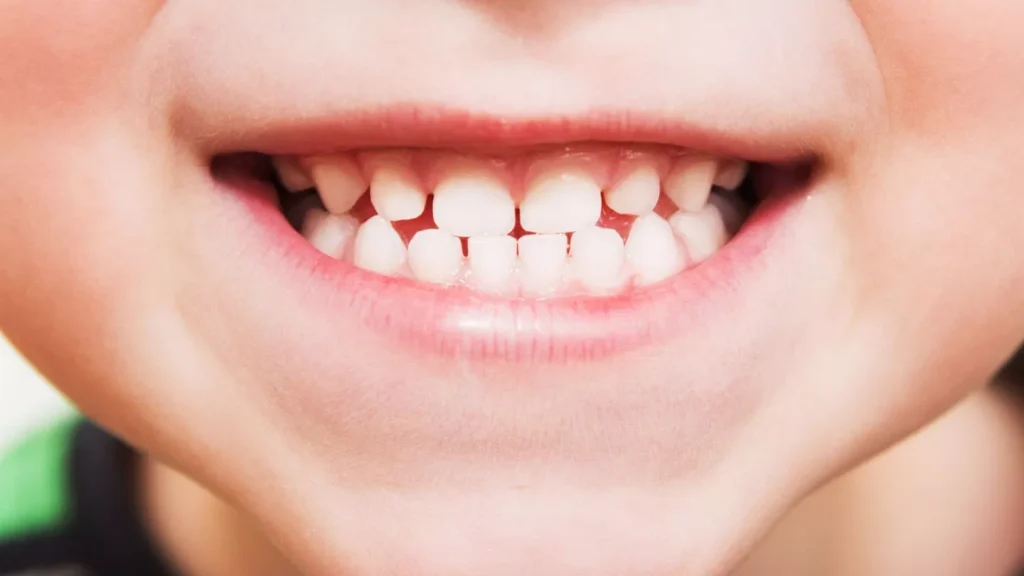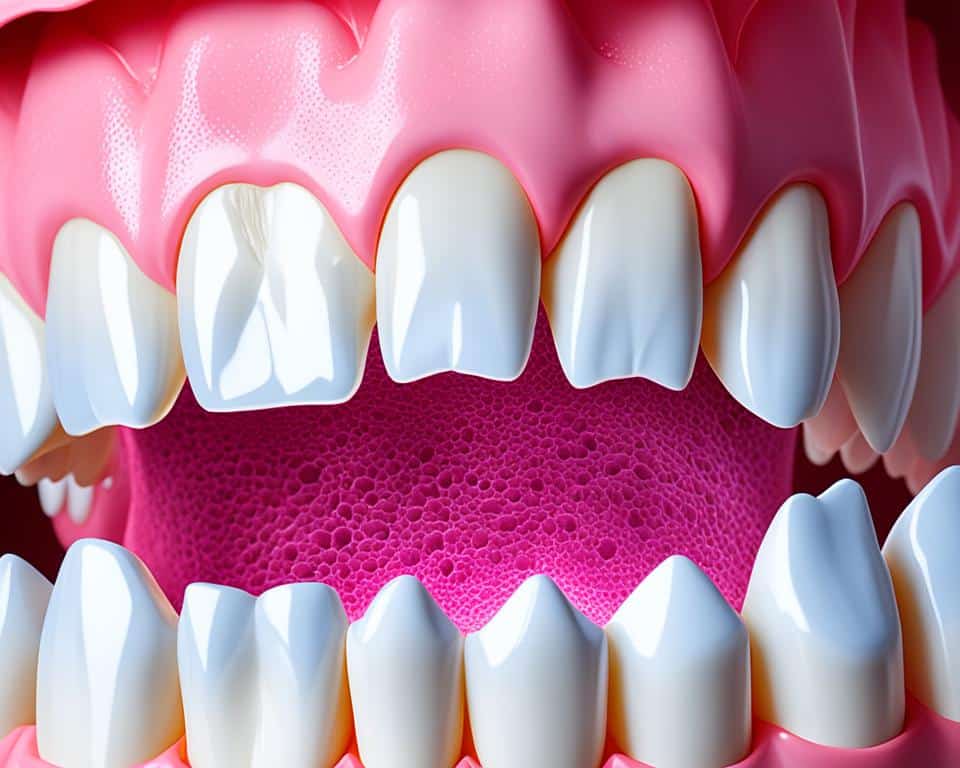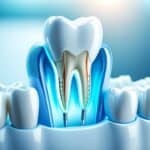
Dentistry in Japan is about to change in a big way, thanks to Toregem Biopharma and Kyoto University. They are leading the charge in a new kind of dentistry that could let people regrow new teeth. This exciting science could change the game for dental regeneration, introducing a drug that helps new teeth grow. They’re getting ready to start tests in July 2024, a big moment for Japan’s dental breakthroughs.
Key Takeaways
- They’ve created a unique drug that might make dental implants and dentures unnecessary.
- Japanese researchers are working on a way for us to regrow new teeth naturally.
- This could revolutionize dental regeneration, offering a fix for lost or decaying teeth.
- The efforts of Toregem Biopharma in regenerative dentistry might just make history.
- Everyone is waiting for the trials to start, hoping for innovative tooth regrowth.
- We’re looking closer at how these Japan’s dental breakthroughs could change oral health forever.
The Dawn of Dental Regeneration: An Overview of Japanese Innovations
Japanese researchers are opening a new page in dental medicine through tooth regrowth technologies. The world is watching, amazed at these scientific leaps that could change dental care forever. It feels like we’re moving from science fiction to reality, thanks to hardworking experts and key institutions.
These advancements aim to let people regrow their natural teeth. This isn’t about using artificial materials, but the body’s own regeneration abilities. Such breakthroughs in dental procedures could greatly impact lives.
Inspiration behind Toregem Biopharma’s Mission
Dr. Katsu Takahashi leads the way in combining genetics with dental research. His work on gene mutations affecting tooth growth drives Toregem Biopharma. After studying at Kyoto University and researching in the U.S., he’s now close to a big discovery in regenerative dentistry.
Collaboration with Kyoto University: A Synergistic Effort
Toregem Biopharma and Kyoto University are working together. They’re exploring the USAG-1 protein, which is key for teeth growth. This could lead to a new way to regrow teeth. Clinical trials might start by July 2024, with hopes for approval by 2030. Together, they’re working hard to revolutionize dental health.
Regrow New Teeth: Pioneering Research Fuels Hope
A revolution is happening in regenerative dentistry. This area, focusing on tooth restoration techniques, is seeing big changes. Thanks to pioneers like Dr. Katsu Takahashi, there’s new hope. They’re working on ways for new teeth growth. This could completely change how we think about dental care. Everyone is watching, hoping for success in natural tooth regrowth.
Dr. Takahashi started this during his doctoral studies. He looked at gene changes that help teeth form. A big discovery happened in a lab. An antibody drug helped mice grow new teeth. This breakthrough in regenerative dentistry could lead us from fixing teeth to actually growing them anew.
- Pioneering antibody drug trials herald the advent of new teeth growth in animal test subjects.
- Dr. Takahashi’s research infuses new vitality into the dream of natural tooth regrowth, revamping dental restoration methodologies.
- The landscape of tooth restoration techniques is on the cusp of change, with a pivot towards harnessing the body’s innate potential for regrowth.
Understanding Natural Tooth Regrowth: How Tooth Buds Can Revolutionize Dentistry
The ability to regrow new teeth marks a significant advancement in dental rejuvenation. It relies on activating tooth buds. These small cell clusters are ready in our jaws, ready to form new teeth. Scientists exploring these cell groups are paving the way for groundbreaking dental treatments.
The Mystery of Tooth Buds in Human Development
Tooth buds are vital in starting our dental development. They form early but usually don’t become a third set of teeth. Yet, studies show these buds might regrow new teeth if conditions are right. This shows a hidden potential for natural tooth regrowth.
From Inhibiting Proteins to Stimulating Growth
Scientists are now focusing on stopping proteins that block tooth bud growth. This action can wake up these dormant buds. It leads them to become fully developed, natural teeth. This discovery is changing how we think about dental care and repair.

From Mice to Men: The Journey of a Tooth Restoration Technique
The jump from lab wins to real-world use shows big gains in regenerative dentistry. Scientists now aim to change how we see new teeth growth. This tech could make tooth restoration techniques normal in the future.
Early Success in Animal Models: A Glimpse of the Future
Tests on small mammals have been key for dental breakthroughs. These trials prove new tooth regeneration methods work. They hint at big changes for human dental care soon.
- Animal trials showcasing success in mice and ferrets
- Evidence suggesting feasibility of tooth restoration techniques in humans
- A vivid vision of the futuristic potential of regenerative dentistry
Anticipated Trials: The Path to Regulatory Approval
The growth of regenerative science brings excitement for clinical trials. These trials are key for regulatory approval. Success in clinics would be a major leap, opening a new era in dental care.
- Design of clinical trials aimed at children with anodontia
- Methodical steps toward obtaining much-needed regulatory approvals
- Anticipation of public availability of tooth regeneration therapies by 2030
Innovative Tooth Regrowth: Inside the Science of Dental Rejuvenation
Scientists have made a big leap in innovative tooth regrowth. They found a special molecule that could change regenerative dentistry forever. This new method helps our bodies grow back dental tissue instead of stopping overgrowth.
A key gene linked to USAG-1 production was identified by researchers. They created an antibody to block USAG-1 and its effects on stopping tooth growth. This breakthrough paves the way for advanced dental procedures. Now, patients might repair their teeth in a natural, less invasive way.
- Antibody Therapy: Hits the USAG-1 protein directly, letting tooth buds regenerate into full teeth.
- Regenerative Methodology: This new approach uses our body’s natural healing power instead of old dental methods.
As this research moves forward, the potential benefits for people with tooth problems are huge. We’re seeing a change in how we restore teeth. It’s moving towards natural regrowth over fake replacements. A future with innovative tooth regrowth is coming closer to reality.
A Closer Look at the Breakthrough Antibody Drug
The world of dental health is about to change massively with a new antibody drug. This drug, made by Toregem Biopharma and Kyoto University, could allow new teeth to grow. It stops USAG-1, a process that normally prevents new teeth from forming in adults.
Everyone is excited about this discovery because it could change dental care forever. Instead of the usual dental treatments, people could simply grow new teeth. It’s a big deal for anyone worried about their dental health.
The Mechanism of USAG-1 Inhibition
At the center of this discovery is the drug’s ability to target the USAG-1 gene. This stops the gene from working and allows new teeth to grow. It’s a big step in using our body’s biology to fix tooth loss.
Bone proteins are important for growing teeth, but this drug works with Wnt-signaling too. Wnt-signaling is important for cell growth. As we learn more, this could help both kids and adults with their teeth.
Groundbreaking Study: New Teeth Growth in Ferrets
Ferrets are helping show how this drug can make new teeth. Because they are similar to us, ferrets are a good test before trying the drug on people. What we learned from these tests makes scientists hopeful about the drug’s future.
- Understanding the biology behind the drug shows its future potential.
- Studies with ferrets point the way to human clinical trials.
- Being able to grow new teeth could change how we care for our teeth.
The Personal Stories Behind Advanced Dental Procedures
Advances in dental health are changing how we see oral care. Breakthroughs in tooth replacement options and advanced dental procedures come from hardworking people, not just tech. These experts are exploring ways to regenerate dental tissue, moving beyond fake teeth.
Dr. Katsu Takahashi’s Lifelong Quest
Dr. Katsu Takahashi, an oral surgeon, is at the forefront of this change. He’s working on an antibody to help grow new teeth. His journey from a young researcher to a leader shows his dedication to finding new dental solutions.
Dr. Mehmood Asghar’s Expert Perspective
Dr. Mehmood Asghar offers a deep look into tooth replacement options. He points out the need for alternatives to dentures and implants. Asghar believes in boosting our natural healing for healthier, sustainable dental care.
Potential Impact on Tooth Replacement Options
Japan’s advancements in regenerative dentistry may change tooth replacement soon. Instead of old dental prosthetics, there’s a new option surfacing. This option involves growing natural teeth again. It could get rid of problems faced with bridges, dentures, and implants. People who’ve lost teeth might find new hope.
Challenges with Current Tooth Replacement Solutions
Current tooth replacements can’t fully match natural teeth’s function or look. They may need a lot of care and can bring discomfort or bone loss. This shows the limitations patients face in comfort, looks, and oral health. It highlights the need for solutions that use our body’s ability to regrow teeth.
The Promise of a Natural Alternative
Regenerative dentistry’s goal is to enable our bodies to regrow teeth naturally. This could give patients teeth just like their original ones. It would improve their health, wellbeing, and self-esteem. Future tooth replacement could solve physical and emotional problems from tooth loss. This approach would work well with our body’s processes.
- Overcomes the limitations of dentures, bridges, and implants
- Enhances oral health by allowing natural regrowth of teeth
- Improves quality of life by restoring the original dental anatomy
- Confirms the advancements in regenerative dentistry as a cornerstone for future dental care
Anticipating the Future of Regenerative Dentistry
The field of regenerative dentistry is at a turning point, changing how we think about dental care. Groundbreaking advancements are pointing us towards a bright future. Soon, treating missing teeth and regenerating dental tissue will be common, changing oral health forever.
Treating Anodontia: A New Hope for Children and Adults
Missing teeth since birth is a big challenge for people. It affects how they look and eat. But new research in regenerative dentistry is bringing hope. It might let kids and adults grow new, natural teeth, improving dental health and overall happiness.
- Minimized dependency on dental prosthetics
- Enhanced structural support for facial features
- Better nutritional intake due to improved masticatory function
Looking Beyond Prosthetics: Realizing Natural Tooth Restoration
We are now focusing on using the body’s own healing powers for growing new teeth. This marks the beginning of an era where healing is complete and real. It’s a big step forward in dental care.
- Integration of new teeth with existing dental structures
- Preservation of alveolar bone and prevention of resorption
- Avoidance of common prosthetic complications such as peri-implantitis

Regenerative dentistry’s promise extends beyond just theory—it’s becoming a real hope for people with dental issues. With special treatments for anodontia and strategies for regrowing teeth, having natural teeth is closer to reality than ever.
Conclusion
The journey that began in Japan’s exciting research labs is now moving into a new area of dental medicine. It’s filled with hope and possibilities. Toregem Biopharma and Kyoto University have started a new phase for breakthroughs in dental care. They are changing how we think about dental practice. The idea of growing new teeth isn’t just a dream anymore. Now, it’s slowly becoming something we can see and touch. This big step in new teeth growth is leading to big changes in dental health care.
Scientists are using our body’s natural ability to heal to rethink dental restoration. They are working hard to make regenerative solutions a normal part of our lives. Their efforts could give many people the chance to smile freely again. With new discoveries, they combine modern science with our body’s natural healing powers.
As we face this exciting change, it’s clear that dental care is about to embrace wider regenerative solutions. Everyone’s excited about the chance to grow new teeth. It’s not just about improving dental care. It’s also about changing how we see health and wellness. This change points to a new era. Soon, getting new teeth might be as simple as the body healing a cut.
What are the recent breakthroughs in regrowing new teeth in Japan?
Recent breakthroughs in regrowing new teeth in Japan involve advancements in stem cell research and tissue engineering techniques to regenerate dental tissue and promote tooth growth.
How does the process of regrowing new teeth work?
The process typically involves extracting stem cells from the patient’s own dental pulp or other sources, culturing them in a laboratory, and then transplanting them back into the patient’s mouth to stimulate tooth regeneration.
What are the potential benefits of regrowing new teeth?
Regrowing new teeth offers potential benefits such as improved oral health, reduced need for dental implants or dentures, enhanced aesthetics, and better quality of life for individuals with missing or damaged teeth.
Are there any limitations or challenges associated with regrowing new teeth?
Challenges include the complexity of tooth structure, ensuring proper integration with surrounding tissues, and the need for long-term studies to assess safety, efficacy, and potential side effects.
Are regrown teeth identical to natural teeth in terms of appearance and function?
While regrown teeth may resemble natural teeth in appearance and function, further research is needed to achieve optimal aesthetics, strength, and durability comparable to natural teeth.
What types of dental conditions or injuries could benefit from regrowing new teeth?
Regrowing new teeth holds promise for treating various dental conditions, including tooth decay, trauma-induced tooth loss, congenital anomalies, and age-related tooth wear.
How soon could regrowing new teeth become available for clinical use?
While research into regrowing new teeth is ongoing, it may take several years before the technology is widely available for clinical use, as further studies and regulatory approvals are needed.
Are there any ethical considerations associated with regrowing new teeth?
Ethical considerations include patient consent, equitable access to treatment, potential exploitation of vulnerable populations, and ensuring that research adheres to ethical guidelines and principles.
Could regrowing new teeth be used for cosmetic purposes, such as smile enhancement?
Regrowing new teeth could potentially be used for cosmetic purposes, such as filling gaps between teeth or improving the appearance of the smile, but clinical applications would depend on safety and efficacy.
What is the significance of breakthroughs in regrowing new teeth for the field of dentistry?
Breakthroughs in regrowing new teeth represent a significant advancement in the field of dentistry, offering innovative solutions for tooth replacement and regeneration that could revolutionize dental care in the future.
Source Links
- https://www.docseducation.com/blog/it-possible-regrow-human-teeth
- https://www.japantimes.co.jp/news/2023/09/24/japan/science-health/japan-pharma-grows-new-teeth/
- https://m.economictimes.com/news/international/us/medicine-to-regrow-teeth-heres-what-we-know-about-the-experimental-medicine-advanced-to-clinical-trials-in-japan/articleshow/101805702.cms
